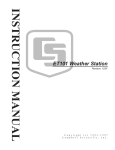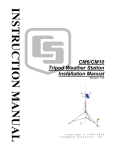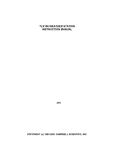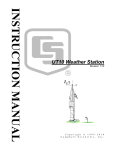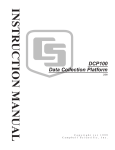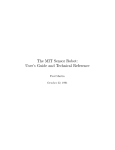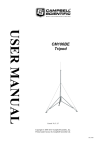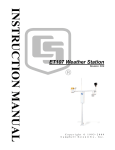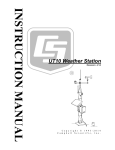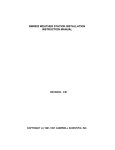Download Campbell ET106 Instruction manual
Transcript
INSTRUCTION MANUAL ET106 Weather Station Revision: 9/02 C o p y r i g h t ( c ) 1 9 9 3 - 2 0 0 2 C a m p b e l l S c i e n t i f i c , I n c . Warranty and Assistance The ET106 WEATHER STATION is warranted by CAMPBELL SCIENTIFIC, INC. to be free from defects in materials and workmanship under normal use and service for twelve (12) months from date of shipment unless specified otherwise. Batteries have no warranty. CAMPBELL SCIENTIFIC, INC.'s obligation under this warranty is limited to repairing or replacing (at CAMPBELL SCIENTIFIC, INC.'s option) defective products. The customer shall assume all costs of removing, reinstalling, and shipping defective products to CAMPBELL SCIENTIFIC, INC. CAMPBELL SCIENTIFIC, INC. will return such products by surface carrier prepaid. This warranty shall not apply to any CAMPBELL SCIENTIFIC, INC. products which have been subjected to modification, misuse, neglect, accidents of nature, or shipping damage. This warranty is in lieu of all other warranties, expressed or implied, including warranties of merchantability or fitness for a particular purpose. CAMPBELL SCIENTIFIC, INC. is not liable for special, indirect, incidental, or consequential damages. Products may not be returned without prior authorization. The following contact information is for US and International customers residing in countries served by Campbell Scientific, Inc. directly. Affiliate companies handle repairs for customers within their territories. Please visit www.campbellsci.com to determine which Campbell Scientific company serves your country. To obtain a Returned Materials Authorization (RMA), contact CAMPBELL SCIENTIFIC, INC., phone (435) 753-2342. After an applications engineer determines the nature of the problem, an RMA number will be issued. Please write this number clearly on the outside of the shipping container. CAMPBELL SCIENTIFIC's shipping address is: CAMPBELL SCIENTIFIC, INC. RMA#_____ 815 West 1800 North Logan, Utah 84321-1784 CAMPBELL SCIENTIFIC, INC. does not accept collect calls. ET 106 Weather Station Table of Contents PDF viewers note: These page numbers refer to the printed version of this document. Use the Adobe Acrobat® bookmarks tab for links to specific sections. 1. Preparation and Siting.............................................1-1 1.1 1.2 1.3 1.4 Installation Tasks .................................................................................. 1-1 Tools Required...................................................................................... 1-2 Siting and Exposure .............................................................................. 1-5 Determining True North for Wind Vane Orientation............................ 1-7 2. ET Tower Installation...............................................2-1 2.1 Base Installation.................................................................................... 2-1 2.2 Tower Installation ................................................................................. 2-3 2.3 Tower Grounding.................................................................................. 2-4 3. ET Instrumentation Installation ..............................3-1 3.1 3.2 3.3 3.4 Enclosure, Datalogger, Power Supply................................................... 3-2 Sensor Connection ................................................................................ 3-5 Communication and Data Storage Peripherals...................................... 3-6 Sealing and Desiccating the Enclosure ............................................... 3-12 4. ET106 Sensor Arm Installation ...............................4-1 4.1 Components .......................................................................................... 4-1 4.2 Installation ............................................................................................ 4-1 4.3 Sensor Connection ................................................................................ 4-1 4.4 034A Wind Sensor Installation ............................................................. 4-2 4.5 RH and Temperature Radiation Shield ................................................. 4-3 4.6 Pyranometer .......................................................................................... 4-3 4.7 Soil Temperature Sensor (Optional) ..................................................... 4-3 4.8 Sensor Verification and Clock Set ........................................................ 4-3 4.9 Upgrading an ET101 to an ET106 ........................................................ 4-4 4.10 Sensor Schematics .............................................................................. 4-6 5. ET Software Installation ..........................................5-1 5.1 Quick Start Review ............................................................................... 5-1 6. Maintenance and Troubleshooting.........................6-1 6.1 Maintenance.......................................................................................... 6-1 6.2 Troubleshooting .................................................................................... 6-3 i This is a blank page. Section 1. Preparation and Siting These guidelines apply to several different Campbell Scientific weather stations. 1.1 Installation Tasks 1.1.1 Indoors • Immediately upon receipt of your shipment… ⇒ Open shipping cartons. ⇒ Check contents against invoice. Contact CSI immediately about any shortages. • Several days prior to the planned installation date… ⇒ Collect tools and site information (Section 1) ⇒ Assemble datalogger, communications device, and power supply in enclosure (Section 3) ⇒ Install datalogger support software on PC (Section 5) ⇒ Establish communications between the datalogger and the PC (Section 5) ⇒ Program datalogger, test sensors, and retrieve data (Section 5) ⇒ Trial run the tower / tripod installation, assembling as much as possible (Section 2) ⇒ Repackage equipment for transport to the field site 1.1.2 Outdoors • Locate suitable site (Section 1) • Prepare tower or tripod base (Section 2) • Tripod and UT10 (3 meter tower) tower stations: ⇒ Raise tripod or tower (Section 2) ⇒ Install instrumentation enclosure (Section 3) ⇒ Install sensors (Section 4) 1-1 Section 1. Preparation and Siting • UT30 (10 meter tower) tower stations: ⇒ Install 3 to 10 meter level sensors (Section 4) ⇒ Raise tower (Section 2) ⇒ Install instrumentation enclosure (Section 3) ⇒ Install 0 to 3 meter level sensors (Section 4) • ET101 / ET106 ET Stations: ⇒ Place instrumentation enclosure low on the ET Tower (Section 3) ⇒ Install sensor option (Section 4) ⇒ Slide enclosure to top of tower and secure with correct orientation (Section 3) 1.2 Tools Required Tools required to install and maintain a weather station are listed below. 1.2.1 Tools for Tower Installation All Towers Shovel Rake Open end wrenches: 3/8", 7/16", ½", (2) 9/16" Magnetic compass 6' Step ladder CM6/CM10 Tape measure (12') Level (12" to 24") Small sledge hammer Teflon tape or pipe dope Allen hex wrench (5/64) UT10 Tape measure (12' to 20') Level (24" to 36") Pick or digging bar Claw Hammer Materials for concrete form: Hand saw (4) 12" wood stakes (1) 2"x 4"x 8' piece of lumber (8) 8p double-head nails (8) 16p double-head nails Concrete trowels (2) 1 to 1.5" thick x 24" boards to support base above forms (optional) Concrete (0.4 cubic yards) 1-2 Section 1. Preparation and Siting ET Tower Tape measure (12’ to 20’) Claw hammer Level (24” to 36”) Hand saw Materials for concrete form: (4) 1" x 2" x 12" stakes (2) 2" x 4" x 96" lumber (12) 8p double-head nails (8) 16p double-head nails 20 ft form wire ½ Yard concrete Concrete trowel, edger Electrical Fish tape or 20 feet of small diameter rope Wheelbarrow UT30 Tape measure (12' and 20') Nut driver (3/8") Level (36" to 48") Small sledge hammer Pliers Tie wire Climbing harness Hard hat Haul rope (50') Non-stretch line (20') Wire rope cutters Materials for B18 Base and UTEYE Anchors: (4) Wood stakes 12" Pick or digging bar Concrete form materials (2"x 4" lumber, stakes, saw, hammer, nails, etc.) Concrete trowel and edger Materials for UTDUK Duckbill Anchors Sledgehammer Highlift jack Chain (to attach jack to anchor loops) Materials for RFM18 Base: (3) anchors appropriate for mounting surface (3) bolts and washers to secure base to anchors 1.2.2 Tools for Instrumentation and Maintenance All Towers Lock and key for enclosure Magnetic declination angle (Section 4) Magnetic compass Straight bit screwdrivers (small, medium, large) Phillips-head screwdrivers (small, medium) Small diagonal side-cuts Needle-nose pliers Wire strippers Pocket knife Calculator Volt / Ohm Meter Electrical Tape 1-3 Section 1. Preparation and Siting Step ladder (6') Datalogger prompt sheet (Section 6) Station manuals Station log and pen Open end wrenches: 3/8", 7/16", ½", (2) 9/16" Socket wrench and 7/16" deep well socket Adjustable wrench Pliers Conduit and associated tools (as required) Felt-tipped marking pen Claw hammer Pipe wrench (12") CM6/CM10 Tape measure (12') Level (12" to 24") Teflon tape or pipe dope UT10 Tape measure (12' to 20') 3/8" nut driver Level (24" to 36") Teflon tape or pipe dope (12) 1/4" washers (for the 015 Crossarm stand only) Allen wrench set UT30 Tape measure (12' to 20') 3/8" nut driver Level (36" to 48") Pliers Climbing harness Hard hats 50' haul rope Crescent wrench Channel-lock pliers 1/4" washers (spacers for U-bolts) 5/64" Allen hex wrench 1.2.3 Supplies for Power and Communications Options AC Power Wire, conduit, and junction boxes as needed Phone Modem Hayes compatible calling modem for PC Phone line to weather station or junction box Short-Haul Modem 4 Conductor communications cable from PC to weather station or junction box 6' copper ground rod and clamp for PC surge protection (optional) 1-4 Section 1. Preparation and Siting 1.3 Siting and Exposure CAUTION If any part of the weather station comes in contact with power lines, you could be killed. Contact local utilities for the location of buried utility lines before digging or driving ground rods. Selecting an appropriate site for the weather station is critical in order to obtain accurate meteorological data. In general, the site should be representative of the general area of interest, and away from the influence of obstructions such as buildings and trees. The weather station should not be located where sprinkler irrigation water will strike sensors or instrument enclosure. Some general guidelines for site selection are listed below, which were condensed from EPA (1988)1, WMO (1983)2, and AASC (1985)3 publications. 1.3.1 Wind Speed and Direction Wind sensors should be located over open level terrain, and at a distance of at least ten times (EPA) the height of any nearby building, tree or other obstruction, as illustrated in Figure 1.3-1. Standard measurement heights: 3.0 m ± 0.1 m recommended (AASC) 2.0 m ± 0.1 m, 10.0 m ± 0.5 m optional (AASC) 10.0 m (WMO and EPA) 1.3.2 Temperature and Relative Humidity Sensors should be located over an open level area at least 9 m (EPA) in diameter. The surface should be covered by short grass, or where grass does not grow, the natural earth surface. Sensors should be located at a distance of at least four times the height of any nearby obstruction and at least 30 m (EPA) from large paved areas. Sensors should be protected from thermal radiation, and adequately ventilated. Situations to avoid include: • large industrial heat sources • rooftops • steep slopes • sheltered hollows • high vegetation • shaded areas • swamps • areas where snow drifts occur • low places holding standing water after rains 1-5 Section 1. Preparation and Siting Standard measurement heights: 1.5 m ± 1.0 m (AASC) 1.25 - 2.0 m (WMO) 2.0 m temperature (EPA) 2.0 m and 10.0 m for temperature difference (EPA) 1.3.3 Precipitation A rain gage should be sited on level ground that is covered with short grass or gravel. In open areas, the distance to obstructions should be two to four times (EPA, AASC) the height of the obstruction. The height of the opening should be as low as possible, but should be high enough to avoid splashing from the ground. Wind shields, such as those used by the National Weather Service, are recommended for open areas. Collectors should be heated, if necessary, to properly measure frozen precipitation. The gage must be mounted above the average level of snow accumulation in areas that experience significant snowfall. Standard measurement heights: 1.0 m ± 1.0 cm (AASC) 30.0 cm minimum (WMO, EPA) 1.3.4 Solar Radiation Pyranometers should be located to avoid shadows on the sensor at any time. Mounting it on the southern most (northern hemisphere) portion of the weather station will minimize the chance of shading from other weather station structures. Reflective surfaces and sources of artificial radiation should be avoided. The height at which the sensor is mounted is not critical. 1.3.5 Soil Temperature The measurement site for soil temperature should be at least 1 m2 and typical of the surface of interest. The ground surface should be level with respect to the immediate area (10 m radius). Standard measurement depths: 10.0 cm ± 1.0 cm (AASC) 5.0 cm, 10.0 cm, 50.0 cm, 100.0 cm (WMO) 1-6 Section 1. Preparation and Siting H REGCOMENDED Feed Serial SENSORS 27115 Portland Or USA REGCOMENDED Feed SENSORS Serial 27115 27115 Portland Or USA DEDNEMOCGER SROSNES 51172 deeF laireS ASU rO dnaltroP H Height of tree (T) 10 T 0 1 FIGURE 1.3-1. Effect of Structure on Wind Flow 1.4 Determining True North for Wind Vane Orientation Magnetic declination, or other methods to find True North, should be determined prior to installing the weather station. True North is usually found by reading a magnetic compass and applying the correction for magnetic declination*; where magnetic declination is the number of degrees between True North and Magnetic North. Magnetic declination for a specific site can be obtained from a USFA map, local airport, or through an internet service called NSSDC CGM (Section 1.4.1). A general map showing magnetic declination for the contiguous United States is shown in Figure 1.4-1. Declination angles east of True North are considered negative, and are subtracted from 0 degrees to get True North as shown Figure 1.4-2. Declination angles west of True North are con-sidered positive, and are added to 0 degrees to get True North as shown in Figure 1.4-3. For example, the declination for Logan, Utah is 14.5° East. True North is 360° - 14.5°, or 345.5° as read on a compass. * Other methods employ observations using the North Star or the sun, and are discussed in the Quality Assurance Handbook for Air Pollution Measurement Systems, Volume IV - Meteorological Measurements4. 1-7 Section 1. Preparation and Siting Subtract declination from 360° Add declination to 0° 20 W 22 E 18 W 16 W 20 E 14 W 12 W 18 E 10 W 8 W 16 E 6 W 4 W 14 E 2 W 0 12 E 10 E 8 E 6 E 4 E 2 E FIGURE 1.4-1. Magnetic Declination for the Contiguous United States 1.4.1 NSSDC CGM Service The NSSDC CGM (Corrected Geomagnetic) Service provides an easy way of determining magnetic declination of a specific site. Since magnetic declination fluctuates with time, it should be determined each time the wind vane orientation is adjusted. It can be accessed on the world wide web at http://nssdc.gsfc.nasa.gov/space/cgm/cgm.html If you know the latitude and longitude of your site, fill out Form 1as shown below for an accurate magnetic declination. If you do not know the latitude and longitude of your site, fill out Form 2 for estimate of magnetic declination. Note that longitude is expressed in 0 to 360 degrees east of the Greenwich prime meridian, and that north latitudes are positive. Query Form 1: Latitude/Longitude Latitude/Longitude below specified in: Geographic Year (from 1945 to 2000): 1998 Altitude above Earth's surface (km) [from 0. to 40000.]: 0 Latitude (degrees) [from -90.00 to 90.00]: 42.03 Longitude (degrees) [from 0.00 to 360.00]: 248.15 Query Form 2: Image Map Year (from 1945 to 2000): 1998 Altitude above Earth's surface (km) [0. - 40000.]: 0 Click on map to specify location and submit: (select area on map provided) A table containing similar information to the following will be returned after submitting Forms 1 or 2. 1-8 Section 1. Preparation and Siting Geographic Lat. Long. Alt. (km) CGM Lat. Long. IGRF Magnetic Field H(nT) D(deg) Z(nt) Lat. 42.03 0. 49.80 20608. 49.68 248.15 311.06 14.417 50505. Dipole Long. 312.14 Magnetic declination is bold in this example to show its location in the table. A positive declination is east, while a negative declination is west. The declination in this example is 14.417 degrees. As shown in Figure 1.4-1, the declination for Logan, UT is east, so True North for this site is 360 - 14.417, or 345.5 degrees. FIGURE 1.4-2. Declination Angles East of True North Are Subtracted From 0 to Get True North FIGURE 1.4-3. Declination Angles West of True North Are Added to 0 to Get True North 1-9 Section 1. Preparation and Siting References 1 EPA, (1987). On-Site Meteorological Program Guidance for Regulatory Modeling Applications, EPA-450/4-87-013. Office of Air Quality Planning and Standards, Research Triangle Park, North Carolina 27711. 2 WMO, (1983). Guide to Meteorological Instruments and Methods of Observation. World Meteorological Organization No. 8, 5th edition, Geneva, Switzerland. 3 The State Climatologist, (1985) Publication of the American Association of State Climatologists: Height and Exposure Standards for Sensors on Automated Weather Stations, v. 9, No. 4 October, 1985. 4 EPA, (1989). Quality Assurance Handbook for Air Pollution Measurement Systems, EPA Office of Research and Development, Research Triangle Park, North Carolina 27711. 1-10 Section 2. ET Tower Installation DANGER: Do not install near power lines. If any part of the tower comes in contact with power lines you could be KILLED. Contact local utilities for the location of buried utility lines before digging or driving grounding rods. CAUTION: Do not fit the 3 meter ET Tower sections together until the appropriate time. Once attached, they cannot be detached. The ET Tower provides a support structure for mounting the ET101 and ET106 weather station components. Figure 2.1-1 shows a typical ET Tower installation option. The tower is designed to withstand winds of 100 mph. The lightning rod assembly is attached after the instrumentation enclosure is installed (Section 3.1). Transformer User Supplied Junction Box 16 VAC Power ET Tower Valve Box 110 VAC Ground Rod Communications Line Direct Bury Splices Concrete Base FIGURE 2.1-1. ET Tower Installation 2.1 Base Installation 2.1.1 Supplied Components (3) ½ inch L-Bolts (9) ½ inch Nuts (1) Anchor Template Refer to Section 1 for components supplied by installer. 2-1 Section 2. ET Tower Installation 2.1.2 Installation 2-2 1. The ET Tower attaches to a user supplied concrete foundation constructed as shown in Figure 2.1-2. 2. Construct the concrete form with 2" x 4" lumber and 16p nails. 3. Assemble the template and anchor bolts. There should be two nuts below and one nut above the template on each bolt. 4. Clear an area large enough to set the form at the desired elevation. 5. Dig a hole 2 feet x 2 feet x 2 feet. Lighter soils may require a deeper hole. About 20 inches below the top of the hole, gouge a small cavity in one wall of the hole. The cavity should be about 4 inches deep and just large enough in diameter to insert one end of the conduit. Make certain the cavity "points" in the direction from which power and communications cables will come. 6. Center the form over the hole. Adjacent to the form, drive four stakes into the soil. Secure the leveled form to the stakes with the 8p nails. 7. Cap the ends of the conduit with duct tape. Position the conduit and wire into place by securing the wire to nails in the form. 8. Fill the hole and form with approximately ½ yard of concrete. Screed the concrete level with the top of the form. Center the template assembly over the conduit and press into the concrete. Put 2 x 4 spacers between the template and the top of the form. The bottom of the bolt threads should be about ½ inch above the concrete. The template must be level in two dimensions. Use a trowel and edger to finish. 9. Wait 24 hours before removing the concrete form. Wait 7 days before mounting the ET Tower. Section 2. ET Tower Installation SIDE VIEW FORM TOP VIEW 2" FORM WIRE NORTH ANCHOR BOLT 24" 24" SMALL CAVITY CEMENT PAD 24" FORM WIRE TEMPLATE FIGURE 2.1-2. ET Tower Base Installation 2.2 Tower Installation 2.2.1 Supplied Components (1) Upper Tower Section (Tapered) (1) Lower Tower Section (6) ½ inch Washers (1) 12 foot 12 AWG Ground Cable (1) Tower Cap (1) 20' communications cable (1) 20' power cable Refer to Section 1 for components supplied by installer. 2.2.2 Installation Attach the tower to the base as shown in Figure 2.2-1. 1. Dig a hole close to the concrete base to access the lower conduit opening. From the hole, trench to the power and communications sources. Remove the duct tape from both ends of the conduit. 2. Remove the template. Attach the two pieces of the tower. This is a permanent connection and cannot be undone. Lay the tower on the ground with the base next to the concrete foundation. 3. Thread communications and power cables through the tower and conduit. Electrical fish tape will help. 2-3 Section 2. ET Tower Installation 4. Cut and save a 9 inch piece of 12 AWG ground wire from the 12 foot length provided. Thread the remaining 11 foot ground wire through the tower. Secure all wiring so it does not slip back into the tower or conduit. 5. Place the tower cap over the tower end. 6. Raise the tower on a still day. Place a washer on top of the two nuts on each foundation bolt. Taking great care not to damage cables between the tower and conduit, raise the tower and lower it onto the conduit and mounting bolts. Install a washer and nut on each bolt and hand tighten. Check plumb of the tower by placing a level on the north and east sides of the lower tower section. Adjust the topmost of the two lower nuts (leveling nut) on each bolt as necessary. When plumb is established, lock the leveling nut in place by tightening the lowest nut against it. Tighten the three top nuts with the wrench. Ground Lug 12AWG Wire 4AWG Cable FIGURE 2.2-1. Raising and Grounding the ET Tower 2.3 Tower Grounding 2.3.1 Supplied Components (1) 5 foot 4 AWG Ground Cable (1) Copper Ground Lug, Bolt (1) Ground Rod, Clamp Refer to Section 1 for components supplied by installer. 2-4 Section 2. ET Tower Installation 2.3.2 Grounding Procedure Ground the tower as shown in Figure 2.2-1. 1. Place the ground rod clamp on the rod. Secure it about 3 inches from the top. Do this before the rod is driven into the ground. Be careful not to damage the clamp with the hammer 2. Taking care not to damage power or communications lines, drive the ground rod close to the foundation using a fence post driver or sledge hammer. Drive the rod at an angle if an impenetrable hardpan layer exists. Soften hard clay soils with water if necessary. 3. Strip 1 inch of insulation from both ends of the 4 AWG ground cable. Strip 1 inch of insulation from the lower end of the 14 AWG ground wire. Install the tower grounding lug to the tower base with the 7/16 bolt provided (Figure 2.1-5). Loosen the lug's set screw and insert the 4 AWG and 14 AWG wire. Tighten the set screw. 4. Loosen the ground rod clamp. Insert the 4 AWG wire. Tighten the clamp (Figure 2.1-5). 2-5 Section 2. ET Tower Installation This is a blank page. 2-6 Section 3. ET Instrumentation Installation The weather station datalogger, power supply, sensor connection panel, communications devices, and data retrieval peripherals are mounted in the ET enclosure at the locations shown in Figure 3-1. Components include: (1) ET Enclosure (1) 4 unit Desiccant Pack (1) Flat Point Screw Driver (1) Power Supply Option (1) Telecommunications Option (1) 9-inch piece of 12 AWG ground wire (1) Lightning rod and clamp Logan, Utah ET101 MADE IN USA ET106 FIGURE 3-1. ET101 and ET106 Instrumentation Mounted on the ET Tower 3-1 Section 3. ET Instrumentation Installation 3.1 Enclosure, Datalogger, Power Supply 3.1.1 Battery Option Installation a) Alkaline Option: The BPALK houses 8 "D" cell batteries. Install it as shown in Figure 3.1-1. Remove the external circuit board with wire and connector by loosening the 2 Phillips head screws. Discard the external circuit board. Mount the BPALK into the enclosure. To install the battery pack, loosen the thumbscrew and remove the cover. Insert the battery pack and plug the battery lead into the connector labeled "ALK". Logan, Utah INTERNAL BATTERY BPALK 12V ALKALINE BATTERY PACK TEMPORARY BATTERY MADE IN USA ALK Battery Connection FIGURE 3.1-1. Alkaline Power Mounting and Connections Solar Panel or 16 VAC Power Cable YUASA LA Battery Connection FIGURE 3.1-2. Rechargeable Power Mounting and Connections b) Sealed Rechargeable Battery Option: Install the kit as shown in Figure 3.1-2. An unregulated solar panel or 17 to 24 VAC must be used with the rechargeable battery at all times. In either case, power is routed through the Heyco fitting on the enclosure back and connected to the CHG ports by depressing connector levers. Polarity of the CHG connection does not matter. Install the rechargeable battery and plug the battery lead into the connector labeled “LA”. 3-2 Section 3. ET Instrumentation Installation 3.1.2 Solar Panel Installation FIGURE 3.1-3. Solar Panel Mounting a) Mount the solar panel to the tower using the mounting brackets as shown in Figure 3.1-3. Mount the solar panel to the tower so it faces south (northern hemisphere). Position it as high off the ground as practical, ensuring it cannot interfere with air flow or sunlight around the sensors. The solar panel should be oriented to receive maximum insolation over the course of the year. Suggested tilt angles (referenced to the horizontal plane) are listed below. Site Latitude Tilt Angle 0 to 10 degrees 10 degrees 11 to 20 Latitude + 5 degrees 21 to 45 Latitude + 10 degrees 46 to 65 Latitude + 15 degrees >65 80 degrees b) After determining the tilt angle, loosen the two bolts that attach the mounting bracket to the panel. Adjust the angle, then tighten the bolts. Secure the lead wire to the mast using wire ties. Make electrical connections as described in 2b above. 3.1.3 AC Power Installation a) The AC power option includes a 120 VAC to 16 VAC. The transformer should be mounted inside a user-supplied junction box according to local electrical codes. Dangerous electrical accidents may be avoided by locating the transformer remotely and burying a low voltage line to the station. The low voltage will carry up to 500 feet on an 18 AWG power cable. 3-3 Section 3. ET Instrumentation Installation b) Shut off 110 VAC power at the main breaker. Connect the primary leads of the transformer to 110 VAC following instructions provided with the transformer. Connect a two-conductor cable to the secondary terminals of the transformer. Route the cable from the transformer to the ET Enclosure according to local electrical codes. 3.1.4 Enclosure Installation 1. Mount and ground the ET enclosure on the ET Tower as shown in Figure 3.1-4. a) Place the enclosure low on the tower. Do not tighten clamps. b) Install the sensor arm (ET106) or reduced sensor set as described in Section 4. 9-inch Ground Wire NOR TH Tower Ground Wire FIGURE 3.1-4. Mounting and Grounding the ET Enclosure c) Slide the enclosure to the top of the ET tower. Position it on the north side of the tower (northern hemisphere). The top of the enclosure should be flush with the top of the tower, with the width of the sensor arm extending above the tower. Tighten the clamps until the enclosure is snug. Do not over-tighten since doing so may damage the tower or enclosure. d) Carefully mount the lightning rod and clamp to the top of the ET Tower. Clearance between the clamp and the enclosure is minimal. Care should be taken not to scratch the enclosure or sensor assembly. Strip 1 inch of insulation from the top end of the 12 AWG green tower ground wire, curl the end and place the curled end under the head of one of the lightning rod clamp bolts. Tighten the bolt. 3-4 Section 3. ET Instrumentation Installation e) Strip 1 inch of insulation from each end of the 9-inch piece of 12 AWG ground wire. Insert one end into the brass ground lug located at the top back of the enclosure. Curl the other end and place under the head of one of the lightning rod clamp bolts. Tighten the bolt. 3.2 Sensor Connection 1) Install the sensor set as described in Section 4. 2) Remove the protective connector cover from the back of the ET Enclosure by removing the two Phillips head screws. Sensors connect to one of seven labeled bulkhead connectors as shown in Figure 3.2-1. Earth Ground Stand off Connector Sensors #4 TEMP CS615 #2 WS/WD #6 SDI 12 GYP BLOCK #7 TEMP #5 RAIN (PRECIP) #1 TEMP / RH #3 SOLAR RADIATION #8 COMM CS I/O POWER CABLE PORT STAND OFF COAXIAL CONNECTION FIGURE 3.2-1. Position of Sensor Bulkhead Connectors 3) Replace the protective connector cover after sensors are connected and power and communications cables are installed. Ensure that all cables and connector caps are under the cover before tightening the screws. 4) Configure sensor switch settings as shown in Figure 3.2-2 if necessary. 3-5 Section 3. ET Instrumentation Installation 604 Ohm (LI190SB) Open (LI1200X) 100 Ohm (LI200S) 1K (HMP35C) Open (CS500, HMP45C) Open SW 12V Open (CS500, HMP45C) (HMP35C) 5V FIGURE 3.2-2. Default Sensor Switch Settings 3.3 Communication and Data Storage Peripherals One communications kit can be mounted to the ET Enclosure back plate. Communications kits ordered with the ET Enclosure are pre-mounted and prewired; no further connections inside the enclosure are necessary. Follow the "External Installation" procedures outlined below to make the external connections. If you received a telecommunications kit separate from the ET Enclosure, follow the "Internal Installation" procedures outlined below. 3.3.1 Phone Modems Phone modems enable communications between the ET Enclosure and a Hayes compatible modem in your PC over a dedicated phone line. Phone line surge protection in built into the ET Enclosure. P/N 10588 Cable RJ11 Patch Cord Ground Wire Modem FIGURE 3.3-1. Phone Modem Mounting and Connections 3-6 Section 3. ET Instrumentation Installation 3.3.1.1 Internal Installation For installation inside the ET Enclosure, the following components are provided in the phone modem kit: (1) COM200 or COM300 Phone Modem (1) 12 inch RJ-11 Patch Cord (1) Mounting Bracket (4) Screws (1) 12 inch 14 AWG Ground Wire Install the phone modem as shown in Figure 3.3-1. 1. Attach the modem to the modem bracket with the 4 screws provided. Mount the modem and bracket into the ET Enclosure with the 3 prethreaded screws on the mounting plate. 2. Connect the modem 9-pin port to the ET Enclosure port with the P/N 10588 ribbon cable supplied with the ET Enclosure. 3. Connect the modem RJ-ll jack to the ET Enclosure RJ-11 jack with the RJll patch cord. 4. Connect the modem ground port to the ET Enclosure ground with the 14 AWG ground wire. 3.3.1.2 External Installation The following modem kit components are used to make the external connections: (1) Direct Bury Splice Kit (1) 20 foot Telephone Patch Cord with Connector 1) Connect the 20 foot patch cord to connector #8 on the external back panel, under the protective cover. 2) Splice the labeled "Tip" and "Ring" lines of the patch cord to the telephone service line. Use the direct bury splice kit when splices are in a valve box or buried. 3.3.2 Cellular Phone Transceiver CAUTION Do not power the transceiver until the antenna is connected! Cellular service and programming of your transceiver must be coordinated with your local cellular provider. Cellular service enables communication between the ET Enclosure and the Hayes compatible modem at your PC without hardwire connections. The cellular transceiver kit must be purchased with one of the phone modem kits. 3-7 Section 3. ET Instrumentation Installation 3.3.2.1 Internal Installation For installation inside the ET Enclosure, the following components are provided in the cell phone modem kit: (1) COM100 Transceiver, Power Connector (1) Mounting Bracket (6) Screws (1) 12 inch Coaxial Patch Cable Install the phone modem and cellular transceiver as shown in Figure 3.3-2. 1. 2. 3. 4. 5. 6. 3-8 Attach the modem to the modem bracket with 4 of the screws provided. Attach the cellular transceiver with 2 of the screws provided. Mount the bracket into the ET Enclosure with the 3 pre-threaded screws on the mounting plate. Mount the RJ11C Interface to the side of the battery bracket. Connect the modem 9-pin port to the ET Enclosure port with the blue 9 pin ribbon cable supplied with the ET Enclosure. Connect the modem RJ-ll jack to the RJ11C Interface with the RJ-ll patch cord. Connect the cellular transceiver coaxial connection to the bulkhead coaxial connector with the coaxial patch cable. Connect the modem ground terminal to the recessed ET Enclosure ground with the 14 AWG ground wire. Do this step after the antenna is connected (Section 3.3.2.2). Connect the transceiver power cord assembly to the transceiver's 25 pin connector. Connect the red 12 V lead to the 12V terminal in the ET Enclosure. Connect the black ground lead to the GND terminal. Connect the green power control lead to the RCV+ and terminal. Section 3. ET Instrumentation Installation Motorola M600 Transceiver COM200 or VS1 Telephone Modem Green Modem Ground Wire to Modem “GND” Terminal Green Modem Ground Wire to Recessed “GND” Lug Blue 9 Pin Ribbon Cable (1 Extra Connector) Cellular Power Connector RJ11C Patch Cord Cellular Handset Connector (normally not used) Black Transceiver Ground Wire to “GND” Red Transceiver 12 Volt Wire to “12 V” Green Transceiver Control Wire to“RCV+” (Program Control Port 2) Power Indicator (do not press) RJ11C Interface Coax Bulkhead Connector Antenna Coax Cable Battery FIGURE 3.3-2. Cellular Phone Mounting and Connection 3-9 Section 3. ET Instrumentation Installation 3.3.2.2 External Installation The following cellular kit components are used to make the external connections: (1) Cellular Antenna (1) 9 foot Coaxial Antenna Cable (1) Antenna Mounting Bracket FIGURE 3.3-3. Cellular Phone Antenna Mounting 1) Mount the antenna to the ET Tower as shown in Figure 3.3-3. 2) Connect the antenna to the external coaxial bulkhead connector with the 9-foot antenna cable. 3.3.3 Short-Haul Modem CAMPBELL SCIENTIFIC LTD SC932 - S/N E1055 QC Short-haul modems enable communication between a datalogger and computer over two twisted pairs of wires. The maximum distance between modems is determined by baud rate and wire gauge. At 9600 baud, the approximate range is 4.0 miles. DCE / DTE switches on the modems are set to DCE. FIGURE 3.3-4. Short-Haul Modem Mounting and Connection 3-10 Section 3. ET Instrumentation Installation 3.3.3.1 Internal Installation For installation inside the ET Enclosure, the following components are provided in the short-haul modem kit: (1) SC932C Interface (1) Rad Modem (1) Rad/SC932C Mounting Bracket (4) Screws (1) 12 inch 4-wire patch cable Install the short-haul modems as shown in Figure 3.3-4 and 3.3-5. 1. Mount the Rad / SC932C mounting bracket into the ET Enclosure with the 3 pre-threaded screws provided. 2. Connect the Rad Modem and SC932C. Strap them into the mounting bracket under the Velcro strap. 3. Connect the SC932C 9-pin port to the internal ET Enclosure 9-pin port with the blue ribbon cable provided. 4. Wire the Rad Modem to the ET Enclosure with the 12-inch patch cord. Match wire labels to wiring panel labels on both the ET Enclosure and the Rad Modem (+XMT to +XMT, etc.). A small screwdriver in provided with the ET Enclosure to access the Rad Modem connections. 3.3.3.2 External Installation The following short-haul kit components are used to make the external connections: At the ET Enclosure: (1) 20 foot 4-Wire Patch Cable (2) 2 Direct Bury Splice Kits (1) Length of User Supplied Wire (Supplier: Anixter, p/n F-02P22BPN, Phone 847-677-2600) At the PC: (1) Rad Modem (1) 5 foot 4-wire Patch Cable (1) 10 foot 14 AWG Ground Wire (1) Surge Protector and Case 1) Connect the 20 foot patch cable to connector #8 on the external back panel of the ET Enclosure. Splice this cable to the user supplied cable, using the direct bury splice kits. 2) Mount the surge protector to a flat surface within 10 inches of the PC's serial port. Ground the center terminal to an earth (or building) ground using the 14 AWG wire. 3-11 Section 3. ET Instrumentation Installation 3) Connect the 5-foot patch cord to the Rad Modem. Fasten the cable to the strain relief tab with a cable tie. Connect the Rad to the PC's serial port either directly (25 pin port) or through a 9 to 25 pin serial converter. 4) Route the user-supplied cable from the remote splice to the surge protector. Connect it and the 5-foot patch cord to the surge protector. - RCV (white) CQ + RCV (green) ET106 ENCLOSURE ET106 ENCLOSURE LLEBPMAC DTL CIFITNEICS 5501E N/S - 239CS - XMT (black) + XMT (red) + RCV (red) - RCV (black) + XMT (green) - XMT (white) To # 8 External Connector Surge Protector PC SRM-5A 1 + RCV (red) - RCV (black) 2 User Supplied Cable Splices 1 + RCV RED 2 - RCV BLACK + XMT (green) 3 - XMT (white) 3 4 4 + XMT GREEN - XMT WHITE Earth Ground FIGURE 3.3-5. Short-Haul Modem Wiring Diagram 3.4 Sealing and Desiccating the Enclosure The ET Enclosure is supplied with a desiccant pack. The desiccant maintains a low humidity in the enclosure to minimize the chance of condensation on the instrumentation. Desiccant should be changed when the internal ET Enclosure humidity sensor measures 30% or higher. Install the desiccant as shown in Figure 3.4-1. Keep unused desiccant tightly sealed in an airtight container. 1) Take the desiccant pack out of its sealed plastic bag. Place it under the desiccant strap just before leaving the station. 2) Be sure to close the enclosure hasp securely. A padlock may be used on the latch for extra security. 3-12 Section 3. ET Instrumentation Installation Desiccant Pack DO NOT EAT UNITED DESICCAN 101CHRISTINE, BELEN, TS-GATES NEW MEXICO 87002 DESI PAK SPECIFICATION MIL-D-3464 TYPE I &II REACTIVATION TIME IN-BAG 16 HOURS AT 250 O F DESICCANT CONTENTS PACKAGE USE ACTIVATED 4 AND STATIC BAGGED FOR UNITS DEHUMIDIFICATION DO NOT EAT UNITED DESICCAN 101CHRISTINE, BELEN, TS-GATES NEW MEXICO 87002 DESI PAK SPECIFICATION MIL-D-3464 TYPE I &II REACTIVATION TIME IN-BAG 16 HOURS AT 250O F DESICCANT CONTENTS PACKAGE USE ACTIVATED 4 AND STATIC BAGGED FOR UNITS DEHUMIDIFICATION FIGURE 3.4-1. Desiccant Installation 3-13 Section 3. ET Instrumentation Installation This is a blank page. 3-14 Section 4. ET106 Sensor Arm Installation 4.1 Components (1) ET106 Sensor Arm (1) Met One 034A Wind Sensor (1) 034A Mounting Shaft (1) Radiation Shield 4.2 Installation Install the ET106 Sensor Arm after the ET Enclosure is mounted low on the ET Tower. You may need to temporarily remove communications option. Mount the sensor arm as shown in Figure 4.2-1 without the wind sensor attached. ET Sensor Arm ET Enclosure Screws (4) FIGURE 4.2-1. ET106 Sensor Arm Mounting 1) Remove the cover from the ET Enclosure 2) Place the sensor arm on top of the enclosure, lining up the four threaded holes on the under side of the arm with the four holes in the top of the enclosure. Attach the arm to the enclosure by inserting and tightening four Phillips head screws. Adjust the position of the ET Enclosure so that the sensor arm is oriented along a due east to due west axis. 4.3 Sensor Connection Refer to Section 3 for sensor connection details. 4-1 Section 4. ET106 Sensor Arm Installation 4.4 034A Wind Sensor Installation Install the 034A Wind Sensor as shown in Figure 4.4-1 after the sensor arm is securely installed. The wind vane is oriented after the datalogger has been programmed (Section 5), and the location of True North has been determined (Section 1.2). Orientation is most easily done with two people, one to aim and adjust the sensor, while the other observes the wind direction displayed by CR10KD Keyboard Display or a laptop PC. FIGURE 4.4-1. Wind and RH/Temperature Sensor Installation 1) Place the 034A in the 034A Mounting Shaft pointing the vane due south. Tighten the alignment screw. 2) Attach the 034A and mounting shaft to the sensor arm. Insert the mounting shaft into the U-bolt clamp. Adjust sensor height to 2 or 3 meters by moving the mounting shaft up or down in the clamp. Lightly tighten clamp nuts. 3) Attach the 034A connector to the 034A. 4) Establish a reference point on the horizon for True North. 5) Sighting down the instrument center line, aim the counter weight at True North. Display input location #8 (Section 4.6) for wind direction using the *6 Mode of the datalogger, or the Monitor Mode of PC208. 6) While holding the wind vane position, slowly rotate the sensor base until the datalogger indicates 0 degrees. Securely tighten the clamp nuts. 4-2 Section 4. ET106 Sensor Arm Installation 4.5 RH and Temperature Radiation Shield Mount the radiation shield to the sensor arm as shown in Figure 4.4-1. Place the RH and temperature assembly inside the shield shaft. Attach the shield to the sensor arm with the two screws. 4.6 Pyranometer Level the pyranometer as indicated in Figure 4.6-1. Adjust the three leveling screws until the bubble level indicates plumb. Remove the red cap from the pyranometer. Leveling Screws FIGURE 4.6-1. Pyranometer Leveling 4.7 Soil Temperature Sensor (Optional) Bury the soil temperature sensor at the desired depth. To minimize solar loading of the sensor cable, bury the cable between the tower base and the sensor. 4.8 Sensor Verification and Clock Set Check the measurements of all sensors after the datalogger is programmed. Display measurements using the *6 Mode with the CR10KD (refer to the laminated prompt sheet, or the Monitor Mode of the PC208 Datalogger Support Software. 4-3 Section 4. ET106 Sensor Arm Installation Input Location Parameter Normal Range 1 Battery (Volt) 9.6 to 14.0 Volts 2 Enclosure Temperature (°C) Close to air temperature 3 Air Temperature (°C) -40° to +50° 4 Air Temperature (°F) -40° to +122° 5 RH (%) 0 to 100% -2 6 Solar Radiation(kW m ) 0 to 1.2 kW m-2 7 Wind Speed (mph) 0 to 110 mph 8 Wind Direction (°) 0 to 359 9 Rain Fall (inches) 0 to .2 10 Soil Temperature 107 -40° to +122°F 28 Enclosure RH -40° to +50°C or 0% to 30% when sealed for several hours Display and set clock time using the *5 mode with the CR10KD (refer to the laminated prompt sheet). 4.9 Upgrading an ET101 to an ET106 The ET101 can be upgraded to an ET106 by installing part number 10574 ET101 to ET106 Upgrade Kit as shown in Figure 4.9-1, 4.9-2, and 4.9-3. 1) Loosen the three leveling screws on the ET101 sensor bracket. Remove the bracket. 2) Move the three leveling screws on the bracket as shown. 3) Remove the white temperature sensor from the bracket by removing the three screws under its base. 4) Reverse the orientation of the bracket, and place it on the upgrade arm. Thread the three leveling screws into the pre-threaded holes two to three turns. 5) Install the sensor arm as described in Sections 4.1 to 4.7. 4-4 Section 4. ET106 Sensor Arm Installation ET101 to ET106 Logan, Utah MADE IN USA FIGURE 4.9-1. Upgrading the ET101 to an ET106 FIGURE 4.9-2. Modifying the Pyranometer Plate 4-5 Section 4. ET106 Sensor Arm Installation Metal Washers FIGURE 4.9-3. Installing Leveling Screws 4.10 Sensor Schematics Schematics of ET106 sensors and associated connectors are provided in Figures 4.10-1, 4.10-2, 4.10-3, and 4.10-4 for help in troubleshooting. Knowledge of the schematics is not necessary for routine installation and maintenance. 3 4 2 6 1 5 Connector Pin Air Temperature and Relative Humidity Sensor Relative Humidity (0-1VDC) 1 Air Temperature (0-1VDC) 2 Not Used 3 12V Switched Supply 4 Analog Ground 5 Shield 6 Datalogger 1H 1L 12VDC Switched Supply AG G FIGURE 4.10-1. Schematic of CS500-LC RH and Temperature Probe and Connector #1 4-6 Section 4. ET106 Sensor Arm Installation Wind Speed and Wind Direction Connector Pin 10K OHM 1K OHM 10K OHM Potentiometer Excitation 3 Wind Direction Signal Return 1 Datalogger E2 2H 3 4 2 6 Analog Ground 2 Wind Speed 4 Pulse Magnetically Activated Reed Switch Ground Shield 1 5 AG P1 5 G 6 G FIGURE 4.10-2. Schematic of 034A-LC Wind Speed and Direction Probe and Connector #2 3 4 2 6 1 5 Connector Pin Solar Radiation Sensor Datalogger 1 3H 40.2 - 90.2 OHM 2 3L Shield Not Used 3 Not Used 4 Not Used 5 6 G FIGURE 4.10-3. Schematic of LI200X-LC Solar Radiation Sensor and Connector #3 4-7 Section 4. ET106 Sensor Arm Installation Connector Pin Tipping Rain Bucket Not Used 1 3 4 2 6 Not Used 2 Not Used 4 Pulse 3 Ground 5 1 5 Datalogger Magnetically Activated Reed Switch Shield P2 G 6 G FIGURE 4.10-4. Schematic of TE525-LC Rain Sensor and Connector #5 4-8 Section 5. ET Software Installation The ET Evapotranspiration Stations are supported by PC120 "ETPro" for MS-DOS. ETPro is used to write and download the station program, and to retrieve and report data. ETPro works in conjunction with PC208 Datalogger Support Software. PC120 and PC208 each have their own manual, which should be consulted for installation procedures and operational details. 5.1 Quick Start Review 1) Start PC120 by entering "ET" at the DOS prompt (refer to the PC120 manual). 2) Create the ET datalogger program by clicking your mouse cursor on the main screen "Edit," then on "Create Station Program" (Edit | Create Station Program). Follow the prompts until you return to the main screen. 3) Click on "Edit | Communications Param." to set up the PC-to-ET telecommunications link. Check the link by attempting to set the clock (Maintenance | Set Clock). 4) Download the program by selecting "Maintenance | Download Station Prog." 5) After at least an hour, retrieve data from the ET datalogger to a comma delimited ASCII file called WEATHER.DAT by selecting "Data | Collect Data." 6) Weather reports can be generated by selecting "Reports | Hourly Summary" or "Reports | Daily Summary." 5-1 Section 5. ET Software Installation This is a blank page. 5-2 Section 6. Maintenance and Troubleshooting These guidelines apply to several different Campbell Scientific weather stations. 6.1 Maintenance Proper maintenance of weather station components is essential to obtain accurate data. Equipment must be in good operating condition, which requires a program of regular inspection and maintenance. Routine and simple maintenance can be accomplished by the person in charge of the weather station. More difficult maintenance such as sensor calibration, sensor performance testing (i.e., bearing torque), and sensor component replacement, generally requires a skilled technician, or that the instrument be sent to Campbell Scientific or the manufacturer. A station log should be maintained for each weather station that includes serial numbers, dates that the site was visited, and maintenance that was performed. 6.1.1 Instrumentation Maintenance The instrumentation requires a minimum of routine maintenance. A few preventative maintenance steps will optimize battery life and decrease the chances of datalogger failure. 6.1.2 Batteries Instruction 10 can be used to measure battery voltage. By recording battery voltage the user can determine how long a fresh set of batteries will last (see the Installation Section of the datalogger Operator's Manual for cold temperature effects on alkaline batteries). Short Cut and ETPro automatically program the weather station to measure battery voltage. When alkaline batteries are used, the battery voltage should not be allowed to drop below 9.6 VDC before replacement. Where CR10 or 21X dataloggers are used in the instrumentation, an external battery must be used to maintain power to the datalogger when changing batteries, otherwise the clock, program, and data will be lost (refer to the Installation Section of the datalogger's Operator's Manual for details). When not in use, remove the eight cells to eliminate potential corrosion of the contact points, and store in a cool dry place. Rechargeable power supplies should be connected to an AC transformer or unregulated solar panel at all times. The charge indicating diode should be "ON" when voltage to the charging circuitry is present. Be aware of battery voltage that consistently decreases over time, which indicates a failure in the charging circuitry. 6-1 Section 6. Maintenance and Troubleshooting 6.1.3 Desiccant Enclosure humidity is monitored in the ET Enclosure and MetData1 systems by an RH chip incorporated into the connector board. Change the desiccant packs when the enclosure RH exceeds 35%. The RH chip should be changed every 3 to 5 years. In standard weather stations, a humidity indicator card is provided with the enclosure. A small RH sensor (10162) can be purchased separately to record the RH inside the enclosure. Change the desiccant when either the card or the sensor read about 35% RH. Desiccant may be ordered through Campbell Scientific (DSC 20/4). Desiccant packs inside of the dataloggers do not require replacement under normal conditions. 6.1.4 Sensor Maintenance Sensor maintenance should be performed at regular intervals, depending on the desired accuracy and the conditions of use. A suggested maintenance schedule is outlined below. 1 week • Check the pyranometer for level and contamination. Gently clean, if needed. • Visually inspect the wind sensors and radiation shield. 1 month • Check the rain gage funnel for debris and level. • Do a visual/audio inspection of the anemometer at low wind speeds. • Check the filter of the temperature/humidity sensor for contamination. General Maintenance • An occasional cleaning of the glass on the solar panel will improve its efficiency. • Check sensor leads and cables for cracking, deterioration, proper routing, and strain relief. • Check the tripod or tower for structural damage, proper alignment, and for level/plumb. 6 months 6-2 • Clean the temperature/humidity sensor. • Clean the Gill Radiation Shield. Section 6. Maintenance and Troubleshooting 1 year • Replace anemometer bearings. • Calibrate the rain gage. • Calibrate the HMP45C/HMP35C probe. • Check calibration of CS500 RH Probe; replace RH chip if necessary. • Check internal RH chip (MetData1 and ET101/106 only). Replace if >5% off. 2 years • Calibrate the solar radiation sensors (some users suggest yearly). • Calibrate the temperature sensor. • Replace the wind vane potentiometer and bearings. 4 - 5 years • Replace sensor cables as required. 6.2 Troubleshooting 6.2.1 No Response Using the Keypad Check keypad response after each of the following steps. A. Make sure the battery has been installed, and the power switch, if any, is "ON" (Section 7). B. Use a voltmeter to measure the voltage on the 12 V and G terminals; the voltage must be between 9.6 and 16 VDC. C. Disconnect any sensor or peripheral wires connected to the 5 V and 12 V terminals. D. Disconnect any communications or storage peripherals from the datalogger. E. Reset the datalogger by turning the power switch to "OFF", then to "ON" or disconnecting and reconnecting the battery. F. If still no response, call Campbell Scientific. 6.2.2 No Response from Datalogger through SC32A or Modem Peripheral At the datalogger: A. Make sure the battery has been installed, and the power switch, if any, is "ON" (Section 7). B. Use a voltmeter to measure the voltage on the 12 V and G terminals; the voltage must be between 9.6 and 16 V DC. 6-3 Section 6. Maintenance and Troubleshooting C. Make sure the datalogger is connected to the modem, and the modem is properly configured and cabled (Section 9). At the computer: D. Make sure the Station File is configured correctly (PC208 Manual). E. Check the cable(s) between the serial port and the modem. If cables have not been purchased through Campbell Scientific, check for the following configuration using an ohm meter: 25-pin serial port: computer end modem end 2 3 7 20 2 3 7 20 9-pin serial port: computer end 2 3 4 5 F. modem end 3 2 20 7 Make sure the modem is properly configured and cabled (Section 9). G. If still no response, call Campbell Scientific. 6.2.3 -99999 Displayed in an Input Location A. Make sure the battery voltage is between 9.6 and 16 VDC. B. With the MetData1 or ET106, verify that the sensor is connected to the proper bulkhead connector. With custom weather stations, verify the sensor is wired to the analog channel specified in the measurement instruction or Short Cut .FSL file (single-ended channels are not labeled on the older silver-colored wiring panels and are numbered sequentially starting at 1H; i.e. 1L is single-ended channel 2). C. Make sure the Range parameter in the measurement instruction covers the full scale voltage output by the sensor. 6.2.4 Unreasonable Results Displayed in an Input Location A. Inspect the sensor for damage and/or contamination. B. Make sure the sensor is properly wired to the datalogger. C. Check the multiplier and offset parameters in the measurement instruction. 6-4 Section 6. Maintenance and Troubleshooting 6.2.5 6999 or 99999 Stored in Final Storage (or Storage Module) A. Final Storage format limitations exceeded (any number larger than 6999 in low resolution, or 99999 in high-resolution format is stored as the maximum number). Change the datalogger program. 6-5 Section 6. Maintenance and Troubleshooting This is a blank page. 6-6 This is a blank page. Campbell Scientific Companies Campbell Scientific, Inc. (CSI) 815 West 1800 North Logan, Utah 84321 UNITED STATES www.campbellsci.com [email protected] Campbell Scientific Africa Pty. Ltd. (CSAf) PO Box 2450 Somerset West 7129 SOUTH AFRICA www.csafrica.co.za [email protected] Campbell Scientific Australia Pty. Ltd. (CSA) PO Box 444 Thuringowa Central QLD 4812 AUSTRALIA www.campbellsci.com.au [email protected] Campbell Scientific do Brazil Ltda. (CSB) Rua Luisa Crapsi Orsi, 15 Butantã CEP: 005543-000 São Paulo SP BRAZIL www.campbellsci.com.br [email protected] Campbell Scientific Canada Corp. (CSC) 11564 - 149th Street NW Edmonton, Alberta T5M 1W7 CANADA www.campbellsci.ca [email protected] Campbell Scientific Ltd. (CSL) Campbell Park 80 Hathern Road Shepshed, Loughborough LE12 9GX UNITED KINGDOM www.campbellsci.co.uk [email protected] Campbell Scientific Ltd. (France) Miniparc du Verger - Bat. H 1, rue de Terre Neuve - Les Ulis 91967 COURTABOEUF CEDEX FRANCE www.campbellsci.fr [email protected] Campbell Scientific Spain, S. L. Psg. Font 14, local 8 08013 Barcelona SPAIN www.campbellsci.es [email protected] Please visit www.campbellsci.com to obtain contact information for your local US or International representative.




















































